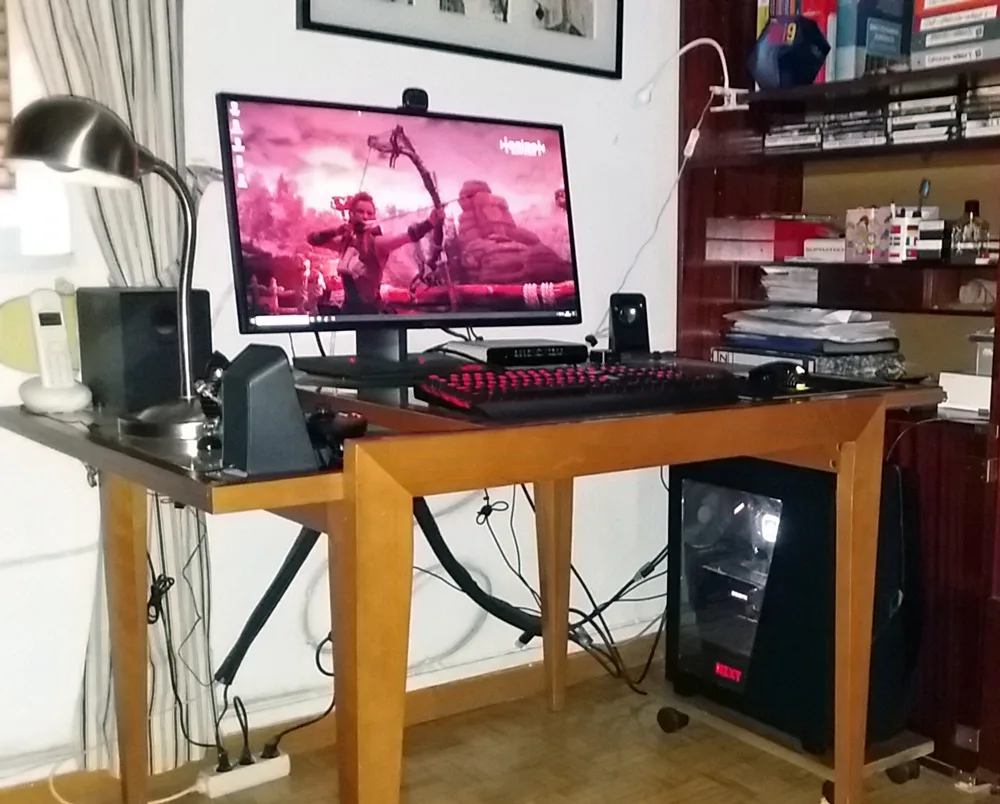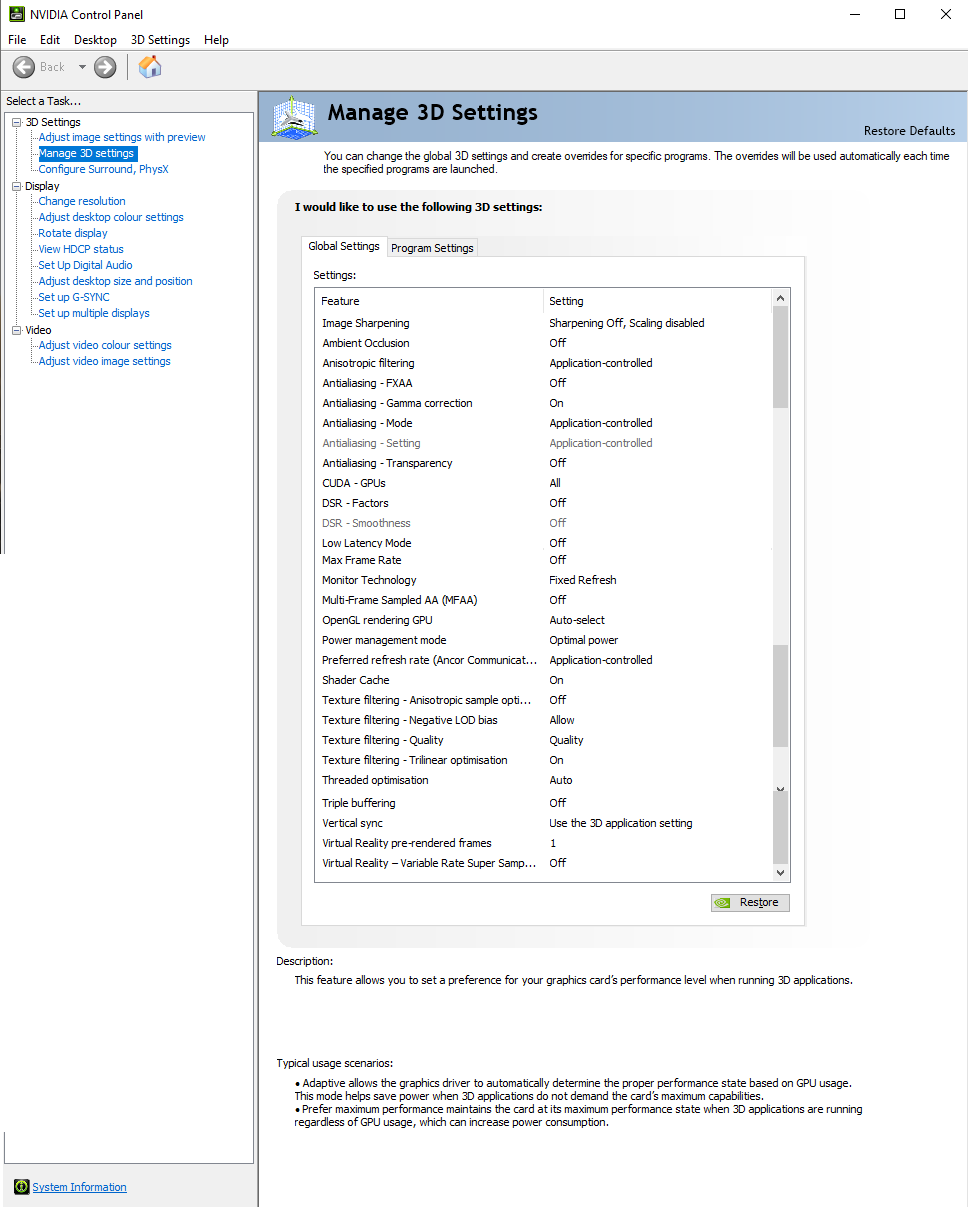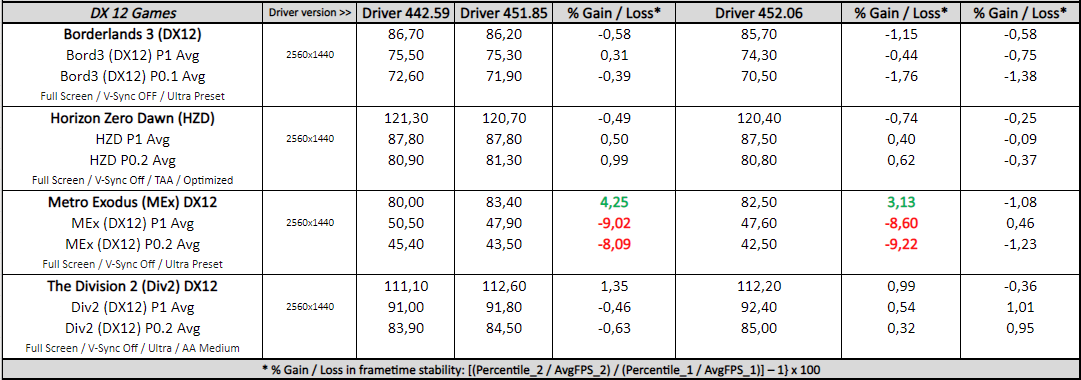Game Ready GeForce 452.06 Driver Performance Analysis featuring a Gigabyte RTX 2080 Ti Gaming OC using 10 12 Games
[Updated 12/22/2020 23:34 PM PT]
This driver performance analysis showcases the performance of a Gigabyte RTX 2080 Ti Gaming OC with 10 12 PC games using the latest GeForce 452.06 Game Ready driver. We compare these drivers versus both 442.59 and 451.85, and we perform all tests on the same game version and the same OS build.
This time, our testing platform is a recent install of Windows 10 64-bit Pro Edition, an i9-9900K with stock clocks, a Gigabyte Z390 Aorus Pro motherboard, and 32GB of Kingston DDR4 3333MHz. The games tested, settings and hardware are identical except for the drivers we compare.

Before offering the performance data and charts of each different analysis scenario, it’s important to describe both the hardware and software configuration used in our testing as well as the analysis methodology.
Benching Methodology
Test Configuration – Hardware
- Intel Core i9-9900K (Hyper-Threading/Turbo boost on; stock settings)
- Gigabyte Z390 AORUS PRO motherboard (Intel Z390 chipset, v.F9 BIOS)
- Kingston HyperX Predator 32GB DDR4 (2×16GB, dual-channel at 3333 MHz CL16)
- Gigabyte GeForce RTX 2080 Ti Gaming OC 11GB, stock clocks
- Samsung 500GB SSD 960 EVO NVMe M.2
- Seagate 2TB Desktop SSHD SATA 3.1
- Seagate 2TB FireCuda SATA 3.1
- Corsair RM750x, 750W 80PLUS Gold power supply unit
- ASUS ROG Swift PG279Q 27? IPS 2560 x 1440 165Hz 4ms G-Sync Monitor (G-Sync Off, Fixed Refresh Rate On)
Test Configuration – Software
- NVIDIA GeForce 452.06, 451.85, and 442.59 drivers; High Quality & prefer maximum performance (on a per-game profile-basis); fixed refresh rate (globally).
- V-Sync application controlled in the control panel, V-Sync Off in-game.
- AA and AF as noted in games; all in-game settings are specified.
- Windows 10 64-bit Pro edition, latest updates v2004, Game Mode, Game DVR & Game Bar features Off.
- GIGABYTE tools not installed.
- Latest DirectX
- All
1012 games are patched to their latest versions at the time of publication. - 3DMark’s suite and UNIGINE Superposition benchmark, the latest version
- Basemark GPU benchmark, v1.1
- CapFrameX (CX), the latest version
- RivaTuner Statistics Server (RTSS), latest version
- Display Driver Uninstaller (DDU), latest version; always uninstall old driver using DDU in safe mode, clean & restart.
-
ISLC (Purge Standby List) before each benchmark.
GeForce Driver Suite-related
- Standard drivers are used.
- The display driver is installed.
- The latest version of PhysX is installed.
Hybrid & Non-Synthetic Tests-related
- Single run per test.
Game Benchmarks-related
- The corresponding built-in benchmark sequence is used.
Frametimes Capture & Analysis tool-related
- CapFrameX is used for capturing and analyzing the relevant performance numbers obtained from each recorded built-in benchmark sequence.
- Consecutive runs until detecting 3 valid runs (no outliers) that can be aggregated by CapFrameX using the following method:
- “Aggregate excluding outliers”
- Outlier metric: Third, P0.2 (0.2% FPS percentile).
- Outlier percentage: 3% (the % the FPS of an entry can differ from the median of all entries before counting as an outlier).
- “Aggregate excluding outliers”
- To compare and value the results and aggregated records in terms of percentages of Gain / Loss, the following thresholds are set to consider a certain % value as significant (not within the margin of error) for our benchmarking purposes:
- Score/FPS Avg > 3% when valuing hybrid & non-synthetic benchmarks;
- FPS Avg > 3% when valuing raw performance;
- P1/P0.2 > 3% when valuing frame time consistency; custom formula
{[(Percentile_2 / AvgFPS_2) / (Percentile_1 / AvgFPS_1)] – 1} x 100
Benchmark Suite: 10 12 PC Games, 3 Hybrid & 3 Non-Synthetic Tests
Hybrid Tests (3DMark)
- Fire Strike Ultra
- Fire Strike Ultra
- Port Royal
Non-Synthetic Tests
- Basemark GPU
- UNIGINE Superposition
- Neon Noir (Benchmark)
DX11 Games
- Borderlands 3 (DX11)
- Deus Ex: Mankind Divided
- Far Cry 5
- Ghost Recon Breakpoint (DX11)
- Neon Noir (Loop Mode)
DX12 Games
- Borderlands 3 (DX12)
- Horizon Zero Dawn
- Metro: Exodus (DX12)
- Tom Clancy’s The Division 2 (DX12)
- Shadow of the Tomb Raider (DX12)
Vulkan Games
- Tom Clancy’s Ghost Recon Breakpoint (VK)
- Strange Brigade (VK)
- Wolfenstein Youngblood
- Quake 2 RTX
[Updated 12/22/2020 23:34 PM PT]
NVIDIA Control Panel settings
Here are the global NVIDIA Control Panel settings:

Both ‘High Quality’ value for texture filtering-quality setting and ‘Prefer maximum performance’ for power management mode are set on a per-game or program profile-basis via Manage 3D Settings > Program settings tab.
GeForce 452.06 Game Ready WHQL Drivers
This latest GeForce Game Ready 452.06 driver was released on Monday (08/17/20) primarily for the August 18 release of Microsoft Flight Simulator. It adds support for 8 more monitors to the G-SYNC compatible list, bringing the total to 110. This new driver also provides the best experience for GeForce gamers who play A Total War Saga: TROY and Tony Hawk’s Pro Skater 1+2.

The download links for the latest GeForce 452.06 drivers can be found starting here. The release notes can be found here as a downloadable pdf file. Here are the release highlights from NVIDIA’s website:
Game Ready Drivers provide the best possible gaming experience for all major new releases. Prior to a new title launching, our driver team is working up until the last minute to ensure every performance tweak and bug fix is included for the best gameplay on day-1.
Game Ready for Microsoft Flight Simulator
This new Game Ready Driver provides the latest performance optimizations, profiles, and bug fixes for Microsoft Flight Simulator. In addition, this release also provides optimal support for World of Warcraft: Shadowlands pre-patch on the public test realm as well as for A Total War Saga: TROY and Tony Hawk’s Pro Skater 1 + 2.
Let’s head to the tables and charts to compare the driver performance changes from the latest GeForce 452.06 driver versus 442.59 and 451.85 drivers.
The Performance Summary Charts with 10 12 Games
Below are the summary charts of our representative selection of 10 12 games and 3 hybrid and 3 non-synthetic benchmarks. We chart the games’ performance to compare the RTX 2080 Ti Gaming OC driver’s performance progression from my old recommended driver 442.59 to the newer 451.85 and finally to the current 452.06 drivers. We list the graphics settings on the charts, and we run the built-in game benchmarks sequence at 2560×1440. You can open each chart in a separate window or tab for best viewing.
Results give average framerates and higher is better. We display the low FPS percentiles (P1 and P0.2) below the corresponding averages. We use CapFrameX to record frametimes over time and to visualize and convert them into their corresponding average FPS and P1 and P0.2 FPS percentiles values. There are also columns showing percentages of gain/loss in both raw performance (average FPS) and, when applicable, in frametimes consistency or stability between the different driver versions. To calculate the gains or losses in stability we applied our custom formula:
{[(LowPercentileFPS_2 / AvgFPS_2) / (LowPercentileFPS_1 / AvgFPS_1)] – 1} x 100
We mark significant performance changes (higher than 3%) in bold and use green or red font for the significant gains or losses respectively.
[Updated 12/22/2020 23:34 PM PT]
Notes on GeForce 452.06 driver performance
From the charts, we see almost no significant performance changes in the tested series of drivers for both the hybrid and non-synthetic tests. The only exception in this group of tests is a significant improvement in the average FPS of the Basemark GPU (DX12) tests when we move from 442.59 to 451.85.
For the built-in game benchmarks, there are some noteworthy (and almost coincidental) FPS average gains in certain games when we move to both 451.85 and 452.06 drivers from the 442.59 driver version, and with only a few consistent and significant regressions in frametimes stability that mostly affects Metro Exodus benches. Lastly, there are no significant performance changes between the two most recent versions, 451.85 and 452.06, in any of the testing scenarios.
Disclaimer
Please be aware that the following results, notes, and the corresponding driver recommendation are valid for similar Turing gaming rigs on Windows 10 v2004. Its representativeness, applicability, and usefulness on different NVIDIA GPU platforms, testing benches, and MS Windows versions may vary.
Conclusion
Based on the previous results and findings, we recommend updating to the latest GeForce 452.06 driver, since its raw performance and smoothness or frametimes consistency level is overall on par with both our prior recommended driver (442.59) and the newer 451.85 drivers too.
From a qualitative point of view, there are important reasons that also make it advisable to upgrade to version 452.06. These reasons include its higher level of security fixes and games’ bug fixes, the support, and optimization for the latest AAA games, and expanded support for G-SYNC compatible monitors and the latest NVIDIA technologies.
***
Rodrigo González (aka “RodroG”) is an enthusiast gamer and tech reviewer interested especially in shooter games, open-world role-playing games, and software and hardware benchmarking. He is the author of the NVIDIA WHQL Driver Performance Benchmarks Series and founder and moderator of the r/allbenchmarks community on Reddit.







Comments are closed.